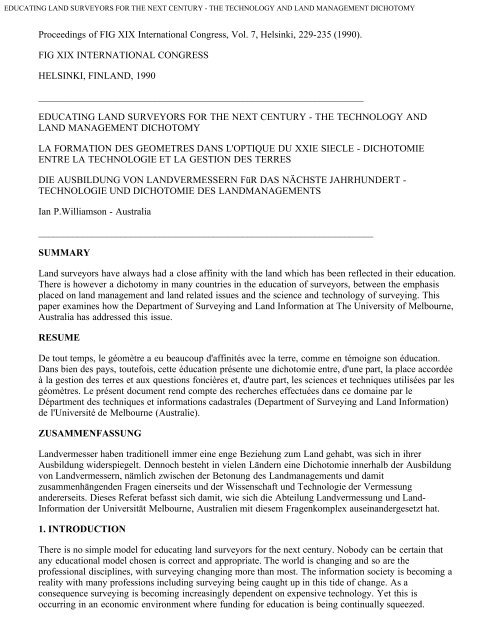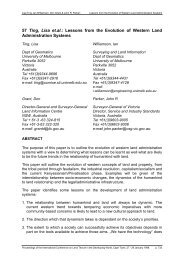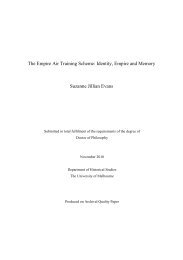Educating land surveyors for the next century: the technology and ...
Educating land surveyors for the next century: the technology and ...
Educating land surveyors for the next century: the technology and ...
You also want an ePaper? Increase the reach of your titles
YUMPU automatically turns print PDFs into web optimized ePapers that Google loves.
EDUCATING LAND SURVEYORS FOR THE NEXT CENTURY - THE TECHNOLOGY AND LAND MANAGEMENT DICHOTOMYwere at <strong>the</strong>ir peak. The last decade has seen a swing back towards a <strong>l<strong>and</strong></strong> focus with particular emphasison <strong>the</strong> management of spatial data in <strong>the</strong> broadest sense <strong>and</strong> <strong>l<strong>and</strong></strong> in<strong>for</strong>mation management. However <strong>the</strong>greatest emphasis in all programs is still <strong>and</strong> will most probably remain, measurement science <strong>and</strong> <strong>the</strong>management of spatial data. This is <strong>the</strong> underlying foundation on which <strong>the</strong> <strong>l<strong>and</strong></strong> related studies build.The dichotomy between measurement science <strong>and</strong> <strong>l<strong>and</strong></strong> related studies becomes increasingly evident whenattempting to design education programs <strong>for</strong> <strong>the</strong> <strong>next</strong> <strong>century</strong>. With <strong>the</strong> expansion of knowledge,individual courses in programs are continually under pressure as to <strong>the</strong>ir relevance <strong>and</strong> necessity,particularly from <strong>the</strong> science <strong>and</strong> computing areas. L<strong>and</strong> related studies are easy to reduce, while at <strong>the</strong>same time <strong>the</strong> environment, natural resource management <strong>and</strong> <strong>l<strong>and</strong></strong> management (especially in urbanareas) are becoming increasingly important.The difficulty arises in not knowing what are <strong>the</strong> requirements of <strong>the</strong> surveying profession or <strong>the</strong> broadneeds of <strong>the</strong> community <strong>for</strong> surveying expertise in <strong>the</strong> year 2000. What is certain however is that <strong>the</strong>courses we teach now <strong>and</strong> during <strong>the</strong> <strong>next</strong> decade will influence to a large extent <strong>the</strong> role <strong>and</strong> skills of <strong>the</strong>profession in <strong>the</strong> future. If <strong>the</strong> educators don't "get it right", <strong>the</strong>y will be responsible <strong>for</strong> undermining <strong>the</strong>future role of <strong>the</strong> surveying profession while at <strong>the</strong> same time not serving <strong>the</strong> communities needs.3. CONSIDERATIONS IN DESIGNING A LAND SURVEYING DEGREE PROGRAMConsidering <strong>the</strong> changing world <strong>and</strong> <strong>the</strong> obvious uncertainties facing <strong>the</strong> surveying profession, it isimportant to maintain flexibility as well as a good foundation of basic principles in any surveyingprogram. Surveying programs should provide a range of career opportunities in measurement science(obviously including <strong>the</strong> range of surveying areas such as engineering surveying, hydrographic surveying,geodetic surveying etc), computing, <strong>l<strong>and</strong></strong> <strong>and</strong> geographic in<strong>for</strong>mation systems, <strong>l<strong>and</strong></strong> management <strong>and</strong>administration, cadastral surveying <strong>and</strong> mapping, <strong>l<strong>and</strong></strong> development, environmental management <strong>and</strong>natural resource management. Surveyors should not necessarily be <strong>the</strong> experts in all <strong>the</strong>se areas but it ishighly desirable that <strong>the</strong>y have sufficient background, confidence <strong>and</strong> skills to move into <strong>the</strong>se areas, inmany cases with <strong>the</strong> addition of fur<strong>the</strong>r studies.In designing surveying programs <strong>for</strong> <strong>the</strong> future <strong>the</strong>re are a few important considerations:a. Measurement science as a discipline <strong>for</strong> <strong>surveyors</strong> is becoming more cohesive. Programs in <strong>the</strong>future will not be dominated by <strong>the</strong> three measurement science streams of geodesy,photogrammetry <strong>and</strong> plane surveying as separate entities to <strong>the</strong> same extent as in <strong>the</strong> past.Measurement science will however continue to be <strong>the</strong> major focus <strong>for</strong> <strong>surveyors</strong> but in a morecohesive <strong>for</strong>m.b. A balance must be struck between <strong>the</strong> sciences, measurement science <strong>and</strong> <strong>the</strong> management ofspatial data, <strong>and</strong> <strong>l<strong>and</strong></strong> management <strong>and</strong> an underst<strong>and</strong>ing of <strong>the</strong> environment. This is essential inorder to maintain <strong>the</strong> <strong>surveyors</strong>' competitive edge. (c) Technology has imposed necessary changeson surveying programs. For example <strong>the</strong> impact of Doppler satellite positioning <strong>and</strong> <strong>the</strong> GlobalPositioning System (GPS) have necessitated fundamental changes to surveying practices, <strong>the</strong> leastnot being a reduction <strong>and</strong> in some cases a disappearance of disciplines such as classical astronomy<strong>and</strong> some of <strong>the</strong> more classical surveying techniques. Analytical photogrammetric instruments havehad a similar impact on photogrammetry as has electronic distance measurement (EDM) onmeasurement practices. Arguably <strong>the</strong> biggest technological impact has been to computing with <strong>the</strong>development of "field to office" systems becoming <strong>the</strong> norm. Overall one of <strong>the</strong> significant impactsof <strong>the</strong>se technologies on surveying education is a reduction in <strong>the</strong> expertise required <strong>for</strong> traditionalfield surveying techniques. It is a concern to many in <strong>the</strong> profession to see non-<strong>surveyors</strong> usingEDM <strong>and</strong> GPS.c. The above changes <strong>and</strong> <strong>the</strong> need <strong>for</strong> flexibility has placed an increasing emphasis on basicprinciples <strong>and</strong> in particular <strong>the</strong> basic sciences. In particular <strong>the</strong>re is an ever increasing requirement
EDUCATING LAND SURVEYORS FOR THE NEXT CENTURY - THE TECHNOLOGY AND LAND MANAGEMENT DICHOTOMY<strong>for</strong> a greater amount of computer science in surveying programs.d. While it is essential to design programs <strong>for</strong> <strong>the</strong> future, it is just as important that <strong>the</strong> presentdem<strong>and</strong>s of <strong>the</strong> profession, industry <strong>and</strong> society are served. The requirements of Boards ofSurveyors in Australia <strong>for</strong> example still need to be fully addressed albeit educators should be tryingto influence <strong>the</strong> requirements of such boards to reflect future practices <strong>and</strong> to discard outdatedrequirements.e. The <strong>surveyors</strong> of <strong>the</strong> future will have to be skilled in <strong>the</strong> management of spatial data in <strong>the</strong> broadestsense. They should be <strong>the</strong> professionals with <strong>the</strong> technical expertise to underst<strong>and</strong> <strong>the</strong> operation <strong>and</strong>data requirements of <strong>l<strong>and</strong></strong> <strong>and</strong> geographic in<strong>for</strong>mation systems.f. Surveyors of <strong>the</strong> future should loose <strong>the</strong>ir "backwoodsman" image. They should become goodmanagers <strong>and</strong> entrepreneurs in applying <strong>and</strong> marketing <strong>the</strong>ir skills.4. THE UNIVERSITY OF MELBOURNE, AUSTRALIA - A CASE STUDYThe Department of Surveying <strong>and</strong> L<strong>and</strong> In<strong>for</strong>mation is located in <strong>the</strong> Faculty of Engineering at TheUniversity of Melbourne. Surveying was first taught in engineering with <strong>the</strong> appointment of <strong>the</strong> firstsurveying lecturer in 1862. The surveying degree was introduced in 1953.In <strong>the</strong> early 1980's <strong>the</strong> Department decided to move its emphasis from <strong>the</strong> traditional geodesy,photogrammetry <strong>and</strong> plane surveying focus to a greater emphasis on <strong>l<strong>and</strong></strong> in<strong>for</strong>mation studies <strong>and</strong> <strong>the</strong>management of spatial in<strong>for</strong>mation in <strong>the</strong> broadest sense. At <strong>the</strong> graduate studies <strong>and</strong> research levels <strong>the</strong>Department wished to consolidate its activities in <strong>l<strong>and</strong></strong> in<strong>for</strong>mation studies <strong>and</strong> in its existing area ofexcellence of high precision measurement, particularly in <strong>the</strong> photogrammetric area. It wanted to alsoexp<strong>and</strong> its already considerable linkages with industry.The Department developed a five year plan which it commenced in 1986 to move in this direction. Amajor component of this plan was <strong>the</strong> implementation of a new undergraduate program. In order toachieve this objective <strong>the</strong> Department did a review of professional <strong>and</strong> community needs, at that time <strong>and</strong>in <strong>the</strong> future, attempted to assess future job prospects <strong>for</strong> <strong>surveyors</strong>, attempted to determine <strong>the</strong> type ofprofessional required to serve those needs <strong>and</strong> fill those jobs, determined <strong>the</strong> skills required to meet thoseneeds <strong>and</strong> <strong>the</strong>n attempted to design a surveying degree which would provide <strong>the</strong> necessary education.Considering <strong>the</strong> new direction of <strong>the</strong> Department towards <strong>l<strong>and</strong></strong> in<strong>for</strong>mation management it became evidentthat <strong>the</strong> profession, industry <strong>and</strong> community required two programs; a modified four year Bachelor ofSurveying program <strong>and</strong> a five year program with a major emphasis on computer science leading to <strong>the</strong>award of two degrees, namely <strong>the</strong> Bachelor of Surveying <strong>and</strong> <strong>the</strong> Bachelor of Science (ComputerScience). These two programs were introduced in 1989 with a combined intake of 45 students. One of <strong>the</strong>hardest tasks however in designing <strong>the</strong>se two programs was to get <strong>the</strong> right balance between basicsciences, measurement science <strong>and</strong> <strong>l<strong>and</strong></strong> related studies.In recognition of <strong>the</strong> new direction <strong>and</strong> activities in <strong>l<strong>and</strong></strong> in<strong>for</strong>mation management, <strong>the</strong> Departmentincluded "L<strong>and</strong> In<strong>for</strong>mation" in its name in 1987, <strong>and</strong> was designated in 1988 as a Centre of Excellenceby <strong>the</strong> international Institute of L<strong>and</strong> In<strong>for</strong>mation based in Washington DC. The primary focus of <strong>the</strong>Department however still is <strong>and</strong> will remain "surveying", as reflected in <strong>the</strong> name of <strong>the</strong> department <strong>and</strong><strong>the</strong> degree.5. THE UNDERGRADUATE PROGRAMSThe four year Bachelor of Surveying program was designed around <strong>the</strong> principles set out above. Theprogram was split into six streams reflecting <strong>the</strong> six major thrusts of <strong>the</strong> program. The streams <strong>and</strong> <strong>the</strong>percentage of time allocated to each stream is set out below:MATHEMATICS AND SCIENCE 20%COMPUTER STUDIES 15%
EDUCATING LAND SURVEYORS FOR THE NEXT CENTURY - THE TECHNOLOGY AND LAND MANAGEMENT DICHOTOMYSURVEYING SCIENCE 27%LAND INFORMATION TECHNOLOGY 9%LAND MANAGEMENT 16%PROFESSIONAL STUDIES 13%"Ma<strong>the</strong>matics <strong>and</strong> science" comprises ma<strong>the</strong>matics, physics, statistics <strong>and</strong> electronics."Computer studies" comprises basic computer science subjects, computer systems <strong>for</strong> <strong>surveyors</strong> <strong>and</strong>computer graphics subjects."Surveying Science" comprises plane, engineering <strong>and</strong> hydrographic surveying, geodesy, photogrammetry<strong>and</strong> geodetic surveying."L<strong>and</strong> in<strong>for</strong>mation <strong>technology</strong>" comprises cartography, spatial analysis, remote sensing, <strong>and</strong> <strong>l<strong>and</strong></strong> <strong>and</strong>geographic in<strong>for</strong>mation systems."L<strong>and</strong> management" comprises <strong>l<strong>and</strong></strong> law, cadastral surveying, <strong>l<strong>and</strong></strong> development, <strong>and</strong> aspects of <strong>l<strong>and</strong></strong>management, <strong>l<strong>and</strong></strong> administration, <strong>l<strong>and</strong></strong> economy, town planning, ecology, geology <strong>and</strong> environmentalassessment."Professional studies" comprises written, verbal <strong>and</strong> graphic communication, introduction to engineering,economics, project planning <strong>and</strong> a minor <strong>the</strong>sis.The combined surveying/computer science degree over five years has basically <strong>the</strong> same program asabove with some reorganization, however it has a strong computer science stream through <strong>the</strong> first fouryears with Year 5 being mainly advanced computer science aimed at in<strong>for</strong>mation <strong>technology</strong> <strong>and</strong> <strong>the</strong>management of spatial data.It is recognized that both <strong>the</strong>se programs are new <strong>and</strong> will need modification over <strong>the</strong> <strong>next</strong> few years.However <strong>the</strong> overall structure is now in place such that improvement is relatively easy. The Departmentbelieves <strong>the</strong> new programs achieve its objectives by providing a sound basis in <strong>the</strong> sciences, a goodbalance between surveying science <strong>and</strong> <strong>l<strong>and</strong></strong> management, provide flexibility <strong>and</strong> options <strong>for</strong> employment<strong>and</strong> serve <strong>the</strong> present needs of <strong>the</strong> surveying, mapping <strong>and</strong> <strong>l<strong>and</strong></strong> in<strong>for</strong>mation industry.6. THE GRADUATE PROGRAMThe undergraduate programs are designed to support <strong>the</strong> graduate program particularly through <strong>the</strong> goodgrounding in <strong>the</strong> basic sciences <strong>and</strong> computer science within a broad <strong>l<strong>and</strong></strong> management environment. Thegraduate program at <strong>the</strong> Masters <strong>and</strong> Doctorate levels are directed mainly at <strong>the</strong> two areas of <strong>l<strong>and</strong></strong>in<strong>for</strong>mation systems <strong>and</strong> high precision measurement.A new nine month graduate diploma in geographic in<strong>for</strong>mation systems will be introduced in 1991 whichwill be jointly managed by a new Centre <strong>for</strong> Environmental <strong>and</strong> Geographic In<strong>for</strong>mation Systems, a jointinitiative between <strong>the</strong> School of Environmental Planning <strong>and</strong> <strong>the</strong> Department of Surveying <strong>and</strong> L<strong>and</strong>In<strong>for</strong>mation. The graduate diploma will draw on <strong>the</strong> strengths of <strong>the</strong> above departments as well as o<strong>the</strong>rparts of <strong>the</strong> University in such areas as computer science, agriculture, <strong>for</strong>estry, geography <strong>and</strong>engineering.An important objective of <strong>the</strong> graduate diploma is to bridge <strong>the</strong> gap between science <strong>and</strong> <strong>technology</strong>, <strong>and</strong><strong>l<strong>and</strong></strong> related studies, as well as provide a relatively short coursework graduate program.7. CONCLUSION
EDUCATING LAND SURVEYORS FOR THE NEXT CENTURY - THE TECHNOLOGY AND LAND MANAGEMENT DICHOTOMYThe surveying profession is undergoing major change due to <strong>the</strong> influence of <strong>the</strong> in<strong>for</strong>mation society,<strong>technology</strong>, <strong>the</strong> environmental agenda, a difficult economic environment <strong>and</strong> <strong>the</strong> general pressure thatmany professions find <strong>the</strong>mselves facing from government <strong>and</strong> society to justify <strong>the</strong>ir existence. Withinthis environment educators are finding it difficult to design appropriate programs such that <strong>the</strong> needs of<strong>the</strong> profession <strong>and</strong> society will be well served into <strong>the</strong> <strong>next</strong> <strong>century</strong>.In designing programs, educators are finding it increasingly difficult to fit all <strong>the</strong> necessary subjects into adegree program. The traditional problem <strong>and</strong> dichotomy of maintaining an appropriate balance betweenmeasurement science <strong>and</strong> <strong>l<strong>and</strong></strong> studies becomes increasingly difficult. Since measurement science is <strong>the</strong>underlying foundation of <strong>the</strong> discipline it is usually <strong>the</strong> <strong>l<strong>and</strong></strong> studies which are under greatest pressure tobe reduced. However to a large extent <strong>the</strong> strength <strong>and</strong> competitive edge of <strong>the</strong> surveying disciplinecomes from its ability to bridge between science <strong>and</strong> <strong>l<strong>and</strong></strong> matters.Un<strong>for</strong>tunately <strong>the</strong>re is no ideal model <strong>for</strong> a surveying degree however <strong>the</strong> experiences of <strong>the</strong> Departmentof Surveying <strong>and</strong> L<strong>and</strong> In<strong>for</strong>mation at The University of Melbourne, Australia suggest that it is importantto maintain or increase emphasis on <strong>the</strong> basic sciences, increase emphasis on computer studies, movetowards <strong>the</strong> management of spatial data in <strong>the</strong> broadest sense, maintain a strong program in <strong>the</strong> <strong>l<strong>and</strong></strong>related subjects, but most importantly maintain flexibility <strong>and</strong> a range of career options <strong>for</strong> <strong>the</strong> <strong>next</strong>generation of <strong>surveyors</strong>.Authors address:Professor I.P.Williamson,Department of Surveying <strong>and</strong> L<strong>and</strong> In<strong>for</strong>mation,The University of Melbourne,Parkville,Victoria,AUSTRALIA 3052Telephone: Intl (613) 3446806FAX: Intl (613) 3472916
















